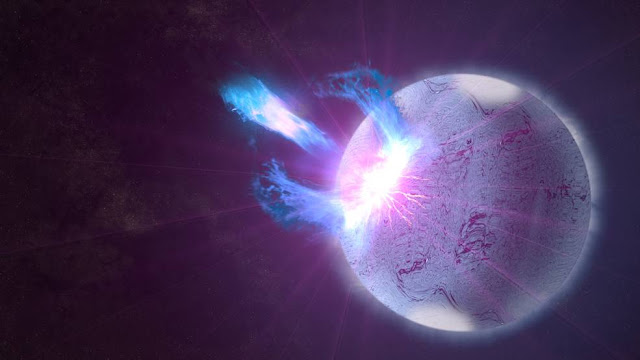 |
| Image: A rupture in the crust of a highly magnetized neutron star, shown here in an artist's rendering, can trigger high-energy eruptions. Fermi observations of these blasts include information on how the star's surface twists and vibrates, providing new insights into what lies beneath. Credits: NASA's Goddard Space Flight Center/S. Wiessinger |
Some of the most intriguing neutron stars are the magnetars: highly magnetised objects whose surface fields are inferred to be in excess of 1014 G in some cases, and whose interior fields may reach 1016 G.
In contrast with many older, more predictable neutron stars, magnetars are volatile, alternating between quiescent states and highly energetic bursts and flares. Their most spectacular events are the giant flares, releasing over ~ 1045 erg of energy in a very brief flash and decaying X-ray tail.
The giant flares of magnetars are believed to be powered by colossal magnetic energy reservoirs.
In a recent paper (Lander 2016) the author sketches an evolutionary picture in which the process of giant flare energy release, from a twisted corona, begins with internal field evolution.
Given the ages of magnetars and the energy of their flares, he suggests that their evolution is driven by a novel evolutionary mechanism: magnetic flux transport/decay due to persistent plastic flow in the crust, which would invalidate the common assumption that the crustal lattice is static and evolves only under Hall drift and Ohmic decay.
He estimates the field strength required to induce plastic flow as a function of crustal depth, and the viscosity of the plastic phase. Field evolution in the superconducting core may also play a role in magnetar field evolution, depending on the star's spindown history and how rotational vortices and magnetic fluxtubes interact.
The author suggests that plastic flow will dominate NS crustal field evolution for B > 1015 G, compete with Hall drift in the outer crust for B ~ 1014 G, and probably be irrelevant for B < 1013 G. This suggests that it plays a key role for young magnetars, in particular.
- Lander 2016 (preprint) - Understanding neutron-star evolution from magnetar flares - (arXiv)
Comments
Post a Comment